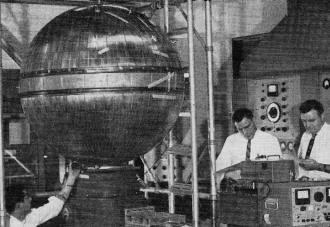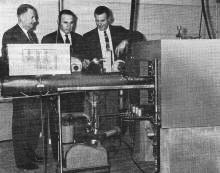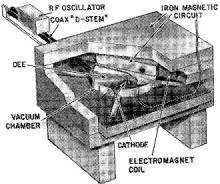|
December 1960 Radio-Electronics
 [Table of Contents] [Table of Contents]
Wax nostalgic about and learn from the history of early electronics.
See articles from Radio-Electronics,
published 1930-1988. All copyrights hereby acknowledged.
|
When I think of the
first space station, what comes to mind is the Russian
Salyut 1 (c1971), and then
America's Skylab (c1973). This "News Briefs" feature in the December 1960 issue
of Radio-Electronics magazine claims there was an earlier space station
- the Courier. OK, NASA
might have called it a space station, but it wasn't a manned space station like
the aforementioned were. It launched in early October of that year. Courier 1B
(its full designation) was the world's first active repeater satellite, which
could receive a message (text, image, voice, or data), store it, then transmit
it later. A few details regarding its operation are provided. Also in the news
was research into using "ball lightning" as a weapon. That's right, shoot a ball
of searing hot plasma toward the enemy to obliterate it - or at least scare the
bejeebers out of
it. I'm pretty sure that technology never reached maturity.
News Briefs
Courier Satellite Is World's First Space Station

The satellite is checked for performance under simulated launching
conditions.
A genuine radio station in space went into action with the launching of the Courier
satellite, Intended to act chiefly as a delayed relay station, storing information
sent to it for later release, it can, of course, act as a simultaneous relay as
well.
The satellite system was conceived by the Army Signal Research and Development
Laboratory at Monmouth, N, J., under direction of the Advanced Research Projects
Agency of the Department of Defense in Washington, D. C. The satellite itself was
designed and developed in Palo Alto, Cali., at the Western Development Laboratories
of Philco Corp., in accordance with specifications by the directing agencies.
The Courier has two complete radio systems. One, operating at vhf, is intended
for tracking and locating; the other, in the microwave region, for actual communication.
The vhf transmitter sends a 50-mw signal. When orbiting, the transmitter is on
for 1 second, then off for 9. The receiver follows with a 1-second listening period.
When the satellite's signal is picked up ground station, a command signal is sent
and it goes into continuous action, sending telemetered data as to the condition
of the satellite and electrical equipment. At the same time, it turns on the microwave
equipment. In all, 35 items are telemetered, ranging from battery voltage and signal
strengths to satellite temperature. The telemetry information is sent by a 1.5 -watt
transmitter. There are two of these, to assure greater reliability. There are also
two 50-mw "acquisition" transmitters.
The satellite has four 5-watt microwave transmitters. Two of them operate at
a time, tuned to slightly different frequencies and connected to different antennas.
Four receivers operate together. The signals received over the microwave link can
be used to modulate the microwave transmitter, relaying the message to a second
ground station, or can be stored. The satellite has five tape recorders to handle
information from high-speed teletype machines or other sources, The information
is transmitted backward on the rewind cycle of the tape, and is reversed again by
being recorded and played back by a tape recorder at the ground station.
Power is supplied by the 19,000 solar cells that cover more than 70% of the total
area of the sphere, The cells are hooked up in series-parallel to deliver 32 volts
to a nickel-cadmium storage battery, Diodes between the batteries and the solar-cell
network prevent reverse current. Diodes are also inserted between each 84-cell unit
of the solar battery and the common bus, since cells on the dark side of the sphere
can dissipate considerable leakage current.
New Compact Cyclotron Is Office-Desk Size

The cyclotron and auxiliary apparatus. The semi-circular chambers
or "dees" are in the huge iron-block electromagnet at right. The charged atom-smashing
particles strike targets inserted at the right face of the block, not visible in
the photograph. Viewers from left to right are - Dr. B. Wilson Lyon, president of
Pomona College; Frank Seaver, college trustee who donated the machine, and Dr. Edward
M. Fryer, acting chairman of the college's physics department.
 A 2,000,000-volt cyclotron no larger than
an office desk was presented to Pomona (Calif.) College by trustee Frank Seaver
as part of the college's 731'd Founder's Day ceremony, It was built by Hughes Aircraft
Co, The cyclotron speeds up charged particles in a pillbox-shaped chamber. The particles
travel in circular paths and get two accelerating "kicks" on each revolution. A 2,000,000-volt cyclotron no larger than
an office desk was presented to Pomona (Calif.) College by trustee Frank Seaver
as part of the college's 731'd Founder's Day ceremony, It was built by Hughes Aircraft
Co, The cyclotron speeds up charged particles in a pillbox-shaped chamber. The particles
travel in circular paths and get two accelerating "kicks" on each revolution.
Technically, a cyclotron is a vacuum chamber containing two semicircular hollow
metal accelerating electrodes called dees (one shown in drawing ): Particles of
hydrogen gas in the chamber are ionized by a hot filament near the center (at end
of. two-wire line). Dees are charged alternately positive and negative by the rf
oscillator in the cage at upper left, which feeds dees through a large coax or dee-stem.
Ions move toward the dee that is negative at the instant and are given a circular
motion by the powerful electromagnetic field generated by the coils of ½-inch
busbar above and below the chamber (top coil shown). The voltage and frequency are
so chosen that, as the particle leaves one dee and enters the other, it finds a
repellent positive charge behind it and an attractive negative one ahead of it.
Thus it travels in a spiral and keeps on gaining speed till it reaches the outside
wall, where it escapes at atom-smashing velocity through an electronic gate into
the target chamber.
This cyclotron can produce protons of 2,000,000 electron-volts or deuterons at
4 mev energy at currents up to 25 μamp, The accelerating voltage is 17.5
kv at 13.8 mc, and the magnetic field 9 kilogauss. Power consumed is 11 kva
at 220 volts.
|
Ball Lightning for Defense?
Electronic fireballs of highly concentrated charged particles (plasma) might
be used to destroy missiles, physicists of the Armour Research Foundation believe.
The balls would be kept active and be guided by a concentration of radar beams.
Data on the subject is being studied by the Air Force, the foundation stated.
The work is based on speculation by Peter Kapitsa, the leading Russian nuclear
scientist, who theorizes that a natural lightning ball is a mass of highly ionized
plasma fed continuously from outside resonance absorption of intense radio waves.
He believes that artificial lightning balls can be created by a powerful source
of sustained radio wav focused into a small volume of space. Natural lightning balls
are most often from 10 to 20 cm in diameter which would indicate wavelengths between
35 and 70 cm, Dr. Kapitsa stated.
|
BBB Cites Electronics Complaints
Third place in the national complaints-by-customers marathon went last year to
the home electronic devices field, Kenneth B, Wilson of the National Better Business
Bureau told the EIA service committee at its recent quarterly meeting. Leader of
the pack was the home-improvement field, runner-up the major household appliance
industry.
Service technicians will be pleased to hear that the larger number of consumer
electronic complaints were directed at the manufacturer, and that many against the
technician were based on customer misunderstanding of manufacturers' warranties.
Wilson offered the following suggestions to the manufacturers' service committee:
Ship only pretested products. Educate the public to the nature and limits of
warranties.
Limit ad claims to the product's field performance; step up replacement parts
availability.
Keep the service industry better informed on products.
Recognize and correct "bugs" promptly.
|
Posted July 2, 2024
|












